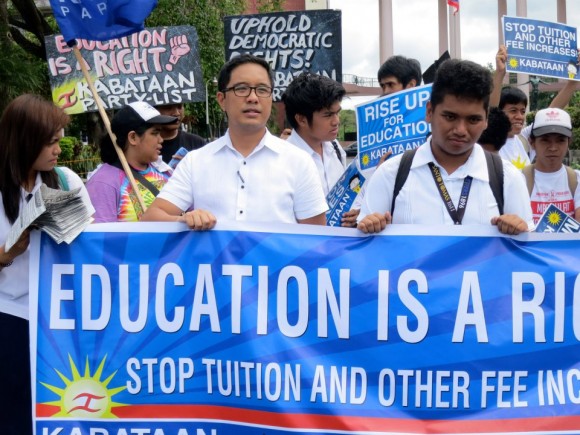
The January-March 2014 issue of Budget Facts and Figures, a newsletter released by the Senate’s Legislative Budget Research and Monitoring Office, reveals that the government expects state colleges and universities (SCU) to generate an income of P7.3-billion from tuition fee collections and another P4.04-billion in “other income collected from students” for fiscal year 2014.
These two items comprise 70.5 percent of expected total SCU income of P16.08-billion for 2014.
In the University of the Philippines, tuition fees have risen exponentially in the past two decades. From a low of P225 per unit in 1994, UP tuition has quickly climbed to P1,500/unit.
A few justify UP tuition increases by saying it is “crazy” not to charge high fees from students coming from high-income families. This is an intellectually-dishonest claim because they gloss over the glaring fact that this absurd idea of faked socialized fees — whether under the former Socialized Tuition and Financial Assistance Program (STFAP) or the new Socialized Tuition System (STS) — has led to higher tuition fees per se for all students and that hocus-pocus is involved in the determination of “subsidies” or “discounts” for students. This indicates that STFAP and the new STS are rackets for imposing and hiding tuition fee increases.
The truly crazy idea is to peg UP tuition to what the richest could pay. Such crazy idea opens the door to endless tuition fee increases and makes UP prone to forget the fundamental differences between itself and other SCUs, on one hand, and private colleges and universities, on the other. Public service vs. profit.
UP’s “socialized fees” actually rest on the assumption that majority would have to pay “full tuition” in order to subsidize those whose fees are fully-discounted or fully-subsidized. Otherwise the system would collapse.
The Polytechnic University of the Philippines, the country’s biggest state university in terms of student population, offers a different picture. Tuition fees there have been kept at P12/unit, despite repeated attempts by both the national government and PUP administrators to raise tuition fees. Community-wide protests have successfully foiled tuition fee increases in the past and even the latest one which would have raised fees by over 800 percent to P100/unit.
Both UP and PUP, as well as other SCUs have been rather clever in raising total matriculation fees. Faced with the prospect of protests if they try to raise the tuition fees, the administrators impose many “other fees” for all sorts of unexplained purposes. The administrators have also raised tuition fees on a per-college basis, as in the case of PUP. Graduate schools and certain undergraduate colleges have been imposing higher tuition than the rest of their universities based solely on the administrators’ capricious determination of their students’ ability to pay.
Tuition-free tertiary education is a concept not alien to the Philippine government. The Philippine Military Academy implements a tuition-free system, with the state practically asking taxpayers to shoulder all expenses for the entirety of the cadets’ stay in the academy — whether tuition, other fees or allowances.
Elsewhere in the country, the City of Manila has, for nearly 50 years now, implemented a tuition-free system for the Pamantasan ng Lungsod ng Maynila’s poor but deserving undergraduate students who live in the capital. Problems though now show in the “miscellaneous fees” charged against all students, regardless of subsidy they receive, and the “socialized” manner of charging fees based on course chosen, place of residence, and degree being sought. PLM’s law and medicine students are charged rates that are “competitive” with private schools. Why PLM or the City of Manila must compete with them as far as tuition is concerned, we simply do not know.

The National Union of Students of the Philippines and other student alliances, and their advocates in and out of government, should be able to make an exhaustive study of the history, basis and trends for tuition and other fees in SCUs and launch a campaign to make education more accessible, especially in tertiary institutions run by the state.
There is a temptation to tie everything to the annual state budget for education since the conventional wisdom is that higher tuition and tuition fee increases are a manifestation of the state’s neglect. That could be partly true since only an additional P11.34-billion theoretically separates us from a regime of tuition-free education in SCUs, a tiny drop in the bucket compared with President BS Aquino’s whooping P150-billion presidential pork barrel.
A more thorough study may lead us to discover, rebel and change a sadder truth: The government is not just starving SCUs of adequate funding and passing the burden of partly financing SCUs to students. They just want to collect tuition fees and to raise fees from the “iskolar ng bayan”, period.
Students, parents and the rest of the nation should fight back this capriciousness of government and SCU administrators, stop the P11.34-billion extortion and find better ways to spend that hard-earned money.
Note: This post was first published in my “Hotspot” column in the Manila Bulletin’s 12 July 2014 issue.